
Cadillac's CTS Sport Wagon adds a significant amount of space while building on the sedan's great styling.
That Cadillac’s CTS sedan is the brand’s most important product goes without saying. Now, Cadillac is copying from the playbook of many other successful automakers such as BMW and Audi by expanding the lineup of its best car.
For 2010, Cadillac added this sleek Sport Wagon to the lineup. And just hitting showrooms now is the sexy coupe along with a go-faster V-Series version.
From the front doors forward, the wagon is pure CTS, and that’s a good thing. The styling is the latest interpretation of Cadillac’s “Art and Science” design, which it introduced with the 1999 Evoq concept car.
It also means that the sedan’s excellent 3.0-liter (new for 2010) and 3.6-liter V-6s carry over as well. Either way, power goes through a 6-speed automatic transmission with manumatic shifting.
The big difference is in back where the wagon has 25 cubic feet behind the rear seats, compared to the sedan’s 13.6-cube trunk. Space grows to 58 cubic feet with the rear seats folded. That’s enough space to cart all of the paraphernalia that goes with a new baby, for instance, although it’s probably not enough space to double as a moving van for when that tot grows up and goes off to college.
The CTS’ wheelbase (113.4 inches) and overall length (191.6 inches) stay the same as the sedan. Surprisingly, the wagon actually undercuts the sedan’s weight by three pounds, tipping the scales at 3,858 pounds.
Cadillac gave the rear compartment some nice features including a cool folding cover over a storage area that can be set up to hold tippy items such as groceries.
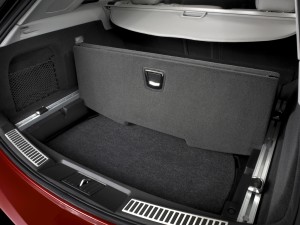
The cargo area has a folding panel that helps keep tippy items such as groceries in place along with nifty rails to attach tie-downs.
The wagon has a sloping roofline, which cuts into the cargo space slightly but gives it a sleek style. One negative of the sleek roof is that the rear window is rather narrow. Also, the D-pillars – the pillars between the rear side windows and the tailgate – are large, creating big blindspots. Surprisingly, a blind-spot recognition system is not available. Another luxury feature that is missing is adaptive cruise control.
Probably the best thing about the Sport Wagon is that from behind the wheel, there is virtually no difference in the driving experience as compared to the sedan.
That means that the car has quick, lively steering, handling to rival some of the best European sports sedans and a (mostly) delightful interior.
With all of the latest electronic controls, spinning the wheels was virtually impossible, even in tight turns and all 304 horses bearing down on the rear wheels. The steering is so accurate, it’s easy to place the car exactly where you want it in hard cornering.
It’s too bad that the car’s front seats are not up to the challenge. It’s not surprising that they are stiff – There’s a reason they call it a Sport Wagon – but, there was no stiffness in the side bolsters, where it’s needed. They’re they type of seats you sit on, not in. They even press uncomfortably on the upper back.
Criticisms of the rest of the interior are few and far between. The pop-up nav screen is a conversation maker and the boatload of buttons begin to make sense after a little time with the car. The sapele wood trim has a beautiful sheen and looks more real than some of the overly processed wood found in many cars.
Rear-seat passengers have good kneeroom, but room to wiggle toes is somewhat lacking if the front seats are in their lowest positions. Headroom was also acceptable for me, at 5-foot-10, even though the car had the double-panel Ultraview sunroof. Surprisingly, the rear seats offers more lateral support than the fronts.
The base wagon comes standard with General Motors’ new 3.0-liter V-6 making 270 horsepower. The test vehicle had the optional 3.6-liter V-6. Both engines use direct injection. Premium fuel is not required, something many of the CTS’ competitors cannot say.
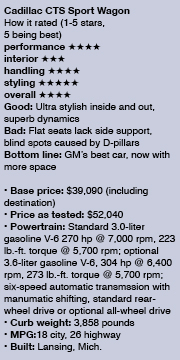 This engine, once exclusively built for the CTS, is now available across the GM lineup from the GMC Acadia to the base version of the Chevrolet Camaro. GM has updated it with the latest technology including direct injection.
This engine, once exclusively built for the CTS, is now available across the GM lineup from the GMC Acadia to the base version of the Chevrolet Camaro. GM has updated it with the latest technology including direct injection.
Many have called the 3.6 GM’s best engine. For duty in the CTS, GM’s engineers massaged it to emphasize smoothness with a more sonorous exhaust sound.
The tranny allows for manual shifting via a gate to the right of the regular shift pattern or buttons on the back of the steering wheel. Like all of these manumatic transmissions, it won’t allow you to shift into a gear that would over-rev the engine. It also will go back to shifting for itself it believes the driver has forgotten to shift.
The Sport Wagon starts at $39,090, including destination charges, a $3,100 premium over the base sedan. Add $1,900 for all-wheel drive. The rear-wheel-drive test car priced out at $52,040.
Need space for four, five in a pinch, plus room to cart all of their stuff? Now Cadillac’s best car is available in the most useful body style on the planet.


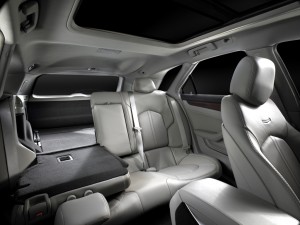
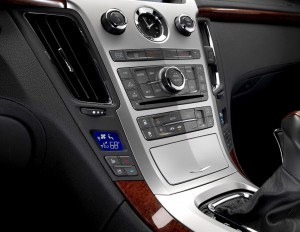
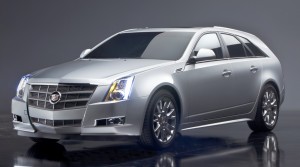
Compare the CTS Sport Wagon to the SRX and the CTS wins in my book.